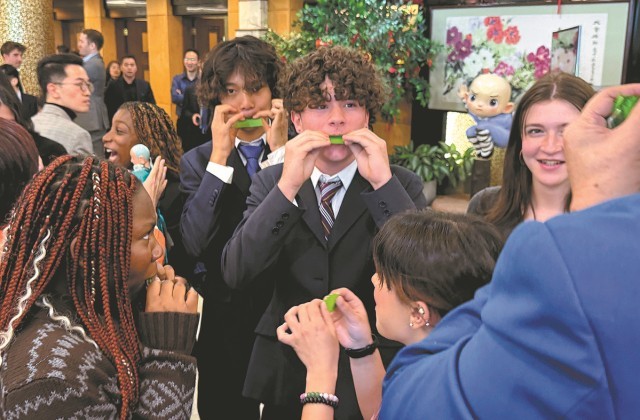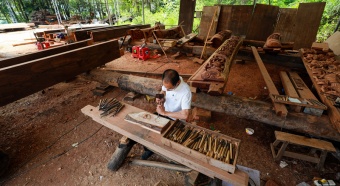
Students try their hand at the Fujian leaf-blowing technique, an intangible cultural heritage of Fujian province, at the Consulate General of China in New York on Monday. MINGMEI LI/CHINA DAILY
Language has served as a vital bridge, deepening understanding between China and the United States across generations of educators and students.
In light of this, the Chinese Consulate General in New York hosted an open day, "Discover China: A Journey Through Language &Culture", for Generation Z students this week.
Featured at the event were traditional Chinese intangible arts from Fujian province, including musical ensembles, folk dances and glove puppetry from the classic 14th-century Chinese novel Water Margin. There was also a panel discussion where participants shared their experiences related to the Chinese language and culture.
Students and representatives from universities and high schools expressed deep interest in learning Chinese and are anticipating visits to China in the near future.
"Learning Chinese is really hard, but it's unique," said Khader Motan, a 16-year-old student from William Bodine High School in Philadelphia, who will be going to China soon.
"I'm really excited to go, see it, travel, and experience China. …Having the chance to experience different educational systems internationally is a really nice and good opportunity."
Myelle Rodgers, a 16-year-old student from Brooklyn Latin School, said it would be an amazing opportunity to engage with and learn more about Chinese culture.
"Not only like learning about our own, but also kind of like teaching the cultures of other nations and countries," she said.
"When it comes to US-China relationships, we are taught that they're kind of like polar opposites in a sense, where that's not really the case because we've seen that a lot of times they have come together to work on amazing solutions and we kind of have to be more open to it and view it from a more collaborative perspective."
Alexander Given, an international relations and Asian studies major at Saint Joseph's University in Philadelphia, said his interest in China began with his father, who traveled there regularly. He has been studying Chinese for seven years.
"A lot of my generation are realizing that US-China relations are one of the most important relations for the world, and a basis of good relations is a basis with good understanding," he said.
Lydia Simon, who graduated from The Ohio State University's advanced Chinese language and culture program, also studied at Peking University in Beijing. She started studying Chinese shortly after the 2008 Beijing Summer Olympics.
"I'm so excited to see so many high school students here," she said.
"There was a lot of excitement internationally about China, and that was a moment for programs to be initiated and a lot of funding to be provided for students."
Simon still remembers the time when she finished an 80-page-long thesis in Mandarin for the completion of her master's degree. At the time, she recalled her "hard" beginning with learning Chinese. But then, she found that she was able to do other things better with her earlier efforts in learning the language.
Support and scholarships
She said she received a lot of support and scholarships to be able to study in China, adding that now is a good time for student exchange programs, following the "50,000-students exchange program in five years" agreement reached by the presidents of China and the US in their November summit in California.
Simon, who currently works in the art industry, said learning Mandarin has helped to pique her interest in the country.
"Tension always comes from misunderstanding, and a lot of misunderstanding comes from not being able to communicate," she said. "It's important that Americans are learning Chinese so that we can better understand each other and have more empathy."
Galal Walker, former professor in the Department of East Asian Languages and Literature at The Ohio State University, said combining the learning of a language while trying to use it can lead to results.
"Encouragement does not come from outside, it comes from inside," he said. "We have to find out how to put the learner in, and build everything around the learner."










